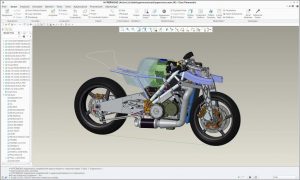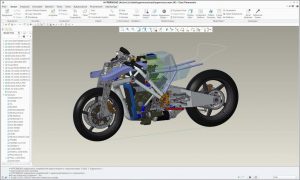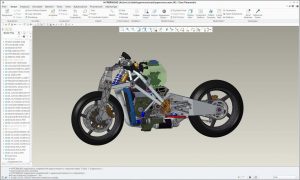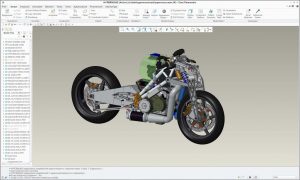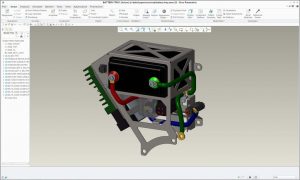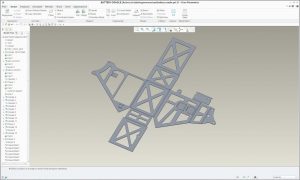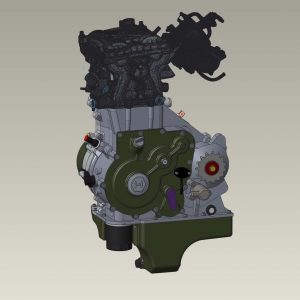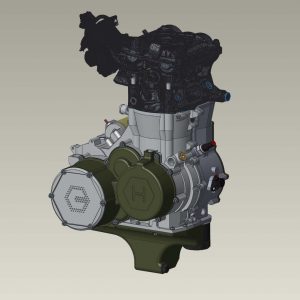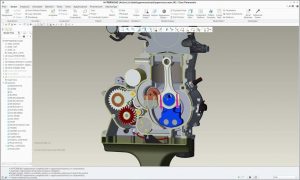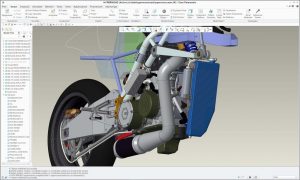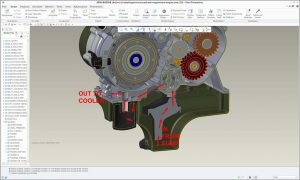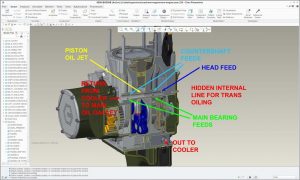So what to do during social isolation while the economy comes screeching to a halt like a Ducati GP bike with warm carbon rotors? Besides clean and organize the shop, that is? Work on the Hypermono design!
After a few days helping various NYC groups design and set up for mass manufacture of plastic PPE masks, I was able to get some solid time on bike design.
Here’s the current status:
The ram air ducts and subframe tubes are placeholders. The fuel tank is partly designed, including the fuel pump/regulator mounting and internal feed lines to the injectors, but the external surfaces await design refinement. Capacity will be somewhere north of 3.5gal. As a naked rolling chassis it looks a bit better (IMO).
Really good progress has been made in all areas, especially in having the engine nearly ready for CAM programming. I am putting a lot of thought into making discrete sub-assemblies and having the bike both easy to assemble and easy to work on at the track. The bike is very dense and packaging everything that is needed is becoming a greater and greater challenge but thankfully not much is left to add. Detail areas like battery tray, ECU, sensor, relay, and electrical components mounting have all been either resolved or a definite path to resolution has been seen.
The battery tray is an example of the detailing. It mounts on the engine above the transmission area and below the fuel tank/airbox:
It is a discrete sub-assembly designed around an AntiGravity AG-801 8-cell Lithium battery and houses the battery, vibration isolation, regulator/rectifier, starter relay, a ground post, and mounting points for several harness connectors. The connections to the battery are short and shielded form the elements so should provide reliable starting. All electrical components are OEM parts with full waterproofing for ease of servicing and complete reliability in all weather conditions.
The mount is made from a piece of plasma cut and formed titanium sheet. Why titanium? Why not! It is hard to beat for light weight in thin sheet structures. Thin aluminum sheet is weak and easy to ding. Steel is heavy. Titanium is strong, lighter than steel, and its high UTS makes it very resistant to dings and permanent deformation. In a situation where all-out stiffness is not needed, it is hard to beat Ti.
The engine is nearing completion on the design side and almost ready to move to CAM programming.
I am really happy with how the entire design came out. Initially, the crankcases were going to be horizontally split. I’m not sure why, but it always seemed to me to be the style that a single cylinder engine would lend itself to. As the design progressed it became very clear that this was not the case! (no pun intended) The parts just did not want to be horizontally split. I was trying to ignore the assembly difficulties that horizontal splitting presented, but after the 3rd or 4th area where a really clever machining solution would be needed to manufacture the cases, I threw in the towel and went for a vertical split.
Once that happened, progress was swift. Oh, hell, I guess just go with the flow!
The engine internals are about as dense as the rest of the bike. I was worried that placing the counterbalance shaft between the crank and transmission would result in a long engine. Shortening the shift mechanism and making a compact counterbalance shaft, I was able to nest them side by side. This kept the cases compact at the expense of having to fabricate a custom shift drum and shift forks. A small price to pay to keep the heart of the bike as optimized as possible.
Both the crank and the counterbalance shaft have tungsten weights to keep the rotating radii as small as possible yet still give the needed balance factors. The crank balance masses are held in bores in the counterweights by Smally retaining rings while the counterbalance mass is radially bolted on, à la F1 crankshafts. All of the engine sensors are OEM Ducati parts to avoid sourcing problems.
Another area that was given some attention is the radiator assembly and area just behind the front wheel. Due to the setup characteristics of my linkage front end, the front wheel does not move rearwards when the suspension compresses, leaving me a bit of room to tidily fit in come more components.
I was able to draw up some nice multi-functional brackets (again in plasma cut Ti) to mount the radiator, overflow tank, cooling fan, and wire harness routing for the electric water pump, quickshifter sensor, gear position sensor, crank position sensor, and oil pressure sender. On the other side of the bike, a small Setrab oil cooler with high flow fittings mounts to the lower frame rail with 3D printed brackets and completes the bike’s cooling needs.
Since cooling the oil was mentioned, I may as well show the oiling circuit. Oil is the lifeblood of an engine. Keep it cool and an engine can last forever. Let it overheat and the engine will quickly die a horrible death. My aim is for this bike to be ultra-reliable, so it needs to have a very robust oil system that is guaranteed to provide as much clean and cool oil as the engine could even need. I think the result will fit the bill. It is short and simple and uses a spin-on filter that is located so it won’t drench the exhaust or anything else when being changed. The Ducati scavenge and pressure stages are reused so overall flow rates should be up to the task. The scavenge stage operates on the sealed crank/c’balance/piston underside volume to create a partial vacuum to aid in ring sealing and avoiding crankcase ventilation problems. It pushes the oil sucked from the crank chamber out onto the transmission, providing some of its lubrication, which then splashes into the sump. From the sump, the pressure stage takes it and pushes it through the filter, and out of the engine to the oil cooler.
The Setrab cooler is plumbed with high-flow -8AN fittings to reduce pressure loss.
The oil returns to the engine directly into the main oil galley, which has direct drillings to feed the main bearings, counterbalance bearings, and the Panigale cam chain and head oil feed lines. There is also a small hole that is the piston oil jet, which is crucial for cooling high performance, large bore engines.
So far, I think all the bases have been covered and the engine will be a reliable powerhouse. Big predictions, and I can only hope that the reality is all I am hoping it will be.
Since the original racing schedule is completely out the window for obvious reasons, things are not in a big rush. I’m going to continue on refining details for a couple more weeks before freezing the design and moving into the fabrication stage, starting with CAM programming for lots and lots of parts.
Hopefully, sometime soon after that I will be able to announce progress on the visual design aspects, including bodywork, color, and lots of little details that make a motorcycle pleasing to look at. Though I do think the naked bike is beautiful, it does need something more. Those soft details are not something I do well and hopefully the project will attract someone with the passion and skill to pull it off. Spread the word!
That’s all for now. I am looking forward to human ingenuity kicking the ass of the Covid19 virus and allowing us to get back to our normal lives. In the meantime, everyone be healthy.
Chris



